
Pachyrhamma is a genus of cave wēta in the family Rhaphidophoridae, endemic to New Zealand. All species are nocturnal and most use cave habitats.

The Phaneropterinae, the sickle-bearing bush crickets or leaf katydids, are a subfamily of insects within the family Tettigoniidae. They are also known as false katydids or round-headed katydids.

Mecopodinae are a subfamily of bush crickets found in western South America, sub-Saharan Africa, and Asia. In Asia, the distribution includes India, Indochina, Japan, the Philippines, and Malesia to Papua New Guinea and Australasia, including many Pacific islands.
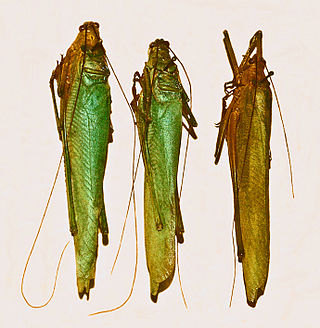
Zeuneria melanopeza is a species of insect in the family Tettigoniidae subfamily Phaneropterinae.

The Hetrodinae are a subfamily of robust bush crickets, also known as armoured katydids, corn crickets, etc. currently including five tribes.

Agraeciini is a large tribe of bush crickets or katydids in the conehead subfamily, Conocephalinae.

Barbitistes constrictus is a species belonging to the family Tettigoniidae subfamily Phaneropterinae. It is found in Austria, Belarus, Central European Russia, Czech Republic, Estonia, Germany, Hungary, Kaliningrad Region, Latvia, Lithuania, North European Russia, Northwest European Russia, Poland, Romania and Slovakia. The species is found mainly in coniferous forests.

Isophya kraussii is a species of insect belonging to the family Tettigoniidae subfamily Phaneropterinae. It is found in Poland, Germany, Austria, the Czech Republic, Slovakia, Slovenia, Croatia and Hungary. The species prefers bushy dry grasslands, forest edges and high-growing, slightly wet meadows. The imagines appear early in the year from about mid-June, but the majority are to be found from July.
Oryctopus is a genus of insect in the subfamily Stenopelmatinae and the sole genus in the tribe Oryctopini. Species have been recorded from India and Sri Lanka.
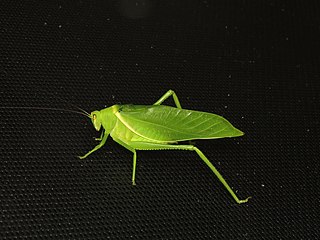
Paracaedicia is a genus of bush cricket in the subfamily Phaneropterinae. Species can be found mostly in New Guinea.
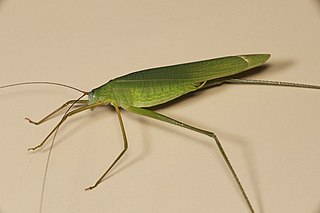
Elimaea is a large genus within Tettigoniidae, the bush cricket or katydid family. Species in this genus are found in India, southern China, Indo-China and Malesia.
Orthelimaea is a genus of Asian bush crickets in the subfamily Phaneropterinae. Species in this genus are found in India, Indo-China, and Malesia.
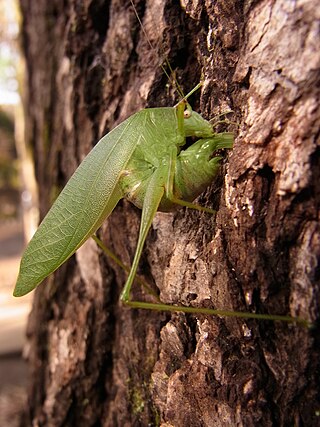
Holochlora japonica, the Japanese broadwinged katydid, is a species of katydid or bush cricket native to eastern Asia in the large subfamily Phaneropterinae.

Orophus tessellatus, the false leaf katydid, is a species of katydid native to Mexico, Central America, and South America. It is in the large subfamily Phaneropterinae within the tribe Amblycoryphini. Its coloring varies from brown to green, some with spots, mottling, or uniform in coloration. The body length reaches 16 mm (0.63 in) in males and 22 mm (0.87 in) in females. The ovipositor is approximate 7 mm (0.28 in) in length. The species is characterized by the size of the forewings and their "dirty" coloring.

Orophus is a small genus of katydids native to Mexico, Central America, and South America.
Hyperbaenus is a genus of South American Orthopterans, sometimes known as 'leaf-folding crickets' in the family Gryllacridinae. It is the type genus for its tribe Hyperbaenini and the new subfamily Hyperbaeninae.

Paragryllacris is a genus of Australian Orthopterans, sometimes known as 'leaf-folding crickets' in the family Gryllacridinae, erected by the Swiss entomologist Carl Brunner von Wattenwyl in 1888. It is fairly typical for its tribe Paragryllacridini. However, in a large comparison of 650 insect species, Australian Raspy Crickets were found to be the insect with the strongest bite.
Neanias is a genus of Orthopterans, sometimes known as 'leaf-folding crickets' in the subfamily Gryllacridinae and tribe Gryllacridini. The recorded distribution is: Indian subcontinent, Japan, Hainan, Indochina, and western Malesia (Sumatra).
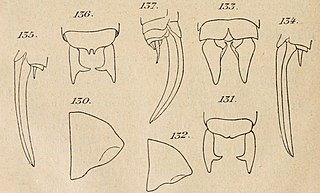
Conocephalus conocephalus is the type species of the conehead genus Conocephalus and the bush cricket tribe Conocephalini. This species has been recorded from southern Europe, including France, and Africa. Described by Carl von Linné in 1767, C. conocephalus appears to have no surviving type specimens, although it is believed that material may have been obtained from Africa.

Ancistrura is a monotypic genus of European bush crickets in the subfamily Phaneropterinae and tribe Barbitistini, erected by Boris Uvarov in 1921.














